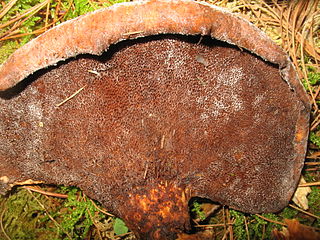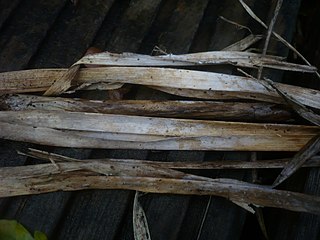Related Research Articles

Phanerochaete is a genus of crust fungi in the family Phanerochaetaceae.

The Meruliaceae are a family of fungi in the order Polyporales. According to a 2008 estimate, the family contains 47 genera and 420 species. As of April 2018, Index Fungorum accepts 645 species in the family.
Roseograndinia is a fungal genus in the family Phanerochaetaceae. It is a monotypic genus, containing the single crust fungus species Roseograndinia rosea, recorded from tropical east Africa and from New Zealand.
Cericium is a fungal genus in the family Cystostereaceae. It is a monotypic genus with the single species Cericium luteoincrustatum, a crust fungus. This species was originally described in 1986 by Kurt Hjortstam and Leif Ryvarden, who called it Amethicium luteoincrustatum. They placed it in the genus Amethicium based on microscopic similarities with the African species Amethicium rimosum.

Hydnophlebia is a genus of five species of toothed crust fungi in the family Meruliaceae. All species are wood-decay fungi that cause a white rot.

Hyphoderma is a genus of crust fungi in the family Meruliaceae. It was circumscribed by German botanist Karl Friedrich Wilhelm Wallroth in 1833.

Dentocorticium is a genus of six species of poroid fungi in the family Polyporaceae. The genus was revised in 2018, with several new species added and some older species transferred to other genera, based on phylogenetic analyses.

Echinochaete is a genus of fungi in the family Polyporaceae. Circumscribed by English mycologist Derek Reid in 1963, the genus is widespread in tropical regions and contains five species.

Epithele is a genus of crust fungi in the family Polyporaceae.

Lopharia is a genus of fungi in the family Polyporaceae. The genus was circumscribed by Károly Kalchbrenner and Peter MacOwan in 1881.
Megasporoporia is a genus of four species of crust fungi in the family Polyporaceae. The genus is characterized by its large spores, and dextrinoid skeletal hyphae.

Nigroporus is a genus of poroid fungi in the family Steccherinaceae. The genus was circumscribed by American mycologist William Alphonso Murrill in 1905. Nigroporus has a pantropical distribution. The genus name combines the Latin word niger ("black") with the Ancient Greek word πόρος ("pore").
Skeletocutis bicolor is a species of poroid crust fungus in the family Polyporaceae. It is found in Singapore.
Skeletocutis borealis is a rare species of poroid fungus in the family Polyporaceae. Found in northern Europe, it was described as new to science in 1998 by Finnish mycologist Tuomo Niemelä.
Crustodontia is a fungal genus of uncertain familial placement in the order Polyporales. The genus was circumscribed in 2005 to contain the crust fungus Crustodontia chrysocreas. This species was originally described as Corticium chrysocreas by Miles Berkeley and Moses Ashley Curtis in 1873. Their description was as follows: "Subiculum bright yellow, thin; hymenium immarginate pallid, or yellow tinged with tawny." Crustodontia has a monomitic hyphal system, meaning it contains only generative hyphae, and these hyphae have clamp connections.
Globuliciopsis is a genus of corticioid fungi in the order Polyporales. It currently contains two species found in Central and South America.
Myriothele is a fungal genus in the family Polyporaceae. It is a monotypic genus, consisting of the single species Myriothele philippiae, a toothed crust fungus found in Réunion.
Neodatronia is a genus of two species of poroid crust fungi in the family Polyporaceae. It was circumscribed in 2014 by Chinese mycologists Bao-Kai Cui, Hai-Jiao Li, and Yu-Cheng Dai as a segregate genus from Datronia. Neodatronia fungi differ microscopically from Datronia by having moderately to frequently branched skeleto-binding hyphae in the context, and by their somewhat smaller spores.
Butyrea is a genus of two species of crust fungi in the family Steccherinaceae.
Grammothele bambusicola is a poroid crust fungus in the family Polyporaceae that is found in Asia. It was described as new to science in 1984 by Norwegian mycologist Leif Ryvarden.
References
- 1 2 Hjortstam, Kurt (1983). "Studies in tropical Corticiaceae (Basidiomycetes). V. Specimens from East Africa collected by L. Ryvarden". Mycotaxon. 17: 555–572.
- ↑ "Record Details: Amethicium chrysocreas (Berk. & M.A. Curtis) Sheng H. Wu". Index Fungorum. CAB International. Retrieved 2016-10-27.
- ↑ "Record Details: Amethicium luteoincrustatum Hjortstam & Ryvarden". Index Fungorum. CAB International. Retrieved 2016-10-27.
- ↑ "Record Details: Amethicium leoninum (Burds. & Nakasone) Sheng H. Wu". Index Fungorum. CAB International. Retrieved 2016-10-27.